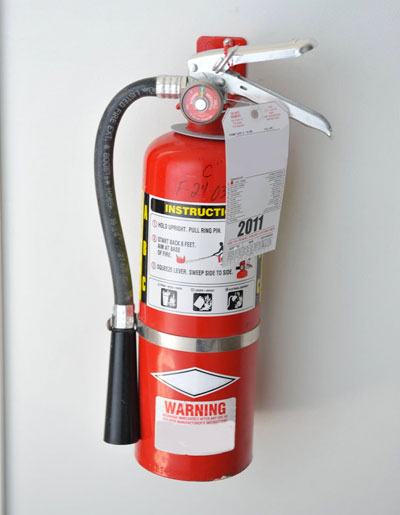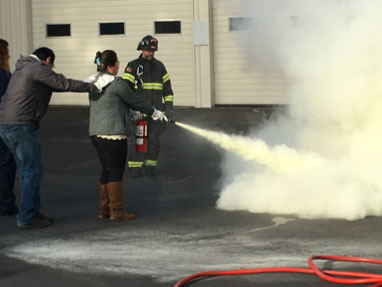Fire Extinguishers
What you should know
- Extinguishers are meant to be used on small fires in their beginning stages and shouldn’t be use on anything larger then a curb side size trash can.
- Extinguishers are labeled with letters and symbols for the classes of fire they can put out. The numbers on the label represent the size of fire that can be put out with that extinguisher. The higher the number the bigger the fire.

- Never use a Class A (water) extinguisher on a flammable liquid or energized electrical fire.
- Class D extinguishers require specialized training.
- Class K extinguishers are used for fighting fire in commercial kitchens where combustible cooking oil is used.
The five classes of fire
| CLASSES | TYPES OF FIRES | SYMBOL |
|---|---|---|
A |
Wood, paper, cloth, trash & other ordinary materials |  |
B |
Gasoline, oil, paint & other flammable liquids |  |
C |
May be used on fires involving live electrical equipment without danger to the operator |  |
D |
Combustible metals & combustible metal alloys |  |
K |
Cooking media (Vegetable or Animal Oils & Fats |  |
There are many types of extinguishers. Read the label to determine the class and size of the fire the extinguisher can be used on.
Fire Extinguisher Maintenance
- Check to make sure pressure gauge is in the green.
- Make sure components are intact and locking device is in place.
- If dry chemical, tap with a rubber mallet once a year to loosen the chemical agent.
- Service extinguishers annually or if it has been discharged.


Before fighting a fire
- Know where extinguishers are located and know how to use them.
- Make sure everyone is evacuating the building and the fire department has been called.
- Never fight the fire alone, use the buddy system and have a clear escape route in case you are unable to put out the fire.
- If the fire is electrical, send someone to the electrical panel to shut power off to the area.
Use P.A.S.S. to extinguish the fire.
PULL the pin.
AIM at the base of the fire from about 8 feet away.
SQUEEZE the handle to discharge the extinguishing agent (do a test spray before approaching the fire to make sure the extinguisher works).
SWEEP the nozzle or hose from side to side. Keep the nozzle aimed at the baes of the fire and sweep back and forth until the flames are out.

Do not fight the fire if
- You don’t have adequate or appropriate equipment.
- You might inhale toxic smoke.
- Your instincts tell you not to.
The VRFA offers fire extinguisher training for businesses and community groups. Please contact us for more information or utilize the ‘make a request’ form on our website.